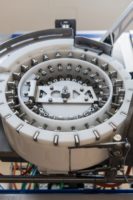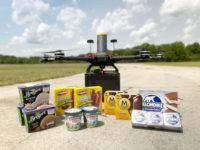The ice cream market is forecast to grow at a compound annual growth rate of 3.8% in value and 2.2% in volume between 2017-2022, according to a study released by Euromonitor, UK. A key driver? A growing demand for premium single-serve ice cream products with new flavors and recipes. Today’s dairy processors increasingly create portfolios of high-quality products that use ingredients in new and interesting ways. In fact, the inclusion of whole nuts, real fruit segments or cookie dough chunks in ice cream is becoming the norm – despite the challenges associated with producing them at scale.
To keep up, the technology behind modern day ice cream production must be highly adaptable, efficient and robust.
Listening to the market
Here is a list of requirements that a new machine would need to produce high-quality ice cream stick products with large inclusions:
- Attractive product appearance. Well-defined corners and flat, smooth surfaces without holes or protruding inclusions to ensure correct chocolate dipping.
- Food safety guarantee. Correct placement of the stick in the center of the product with no risk of damage to the stick.
- Ability to add all types of commonly used inclusions. Soft, medium and hard with flexibility to go up to 25 mm.
- Even distribution of the inclusions in the ice cream product to optimize mouthfeel and overall consumer experience.
- Correct and consistent positioning of the ice cream products on the stainless-steel trays of the extrusion line to minimize waste at the subsequent pickup of the products.
- No use of nitrogen or other materials to reduce production costs and environmental impact.
- Production capacity equal to that of traditional extruded stick products, typically 150-200 products per lane per minute.
Firmly establishing these requirements ensures the creation of machinery that would meet customer needs and offer an adaptable, future-proof solution.
Design and development
After establishing the machine requirements, Tetra Pak initiated a technology development project led by ice cream specialists from Tetra Pak’s ice cream Product Development Centre (PDC) in Aarhus, Denmark and technology specialists from the processing research and development team in Lund, Sweden.
During the first phase of the project, the team selected three concepts for further evaluation, including ultrasonic cutting (method often used for cutting sticky products such as ice cream, as well cheese and cakes products), inclusion-free zone (a coextruded process involving two streams of ice cream – one with inclusions and one without) and vertical rotating wheel.
Compared with the other concepts, the vertical rotating wheel solved the issue of precisely positioning the products on the stainless-steel trays due to the close proximity of the extrusion wheel to the line, releasing the ice cream product gently onto the steel trays of the line. The vertical rotating wheel is a wheel with a horizontal axis, using a number of cavities at its outer surface with the same shape as the final product. After proving the vertical rotating wheel concept and prototype, the next step was to design and build the equipment suitable for continuous daily production. This included incorporating additional requirements for production equipment addressing hygiene and cleanability, operator safety and user-friendliness.
As the market for premium-quality stick ice cream products rapidly expands, addressing the limitations of extrusion-line technology offers ice cream producers a competitive advantage. Achieving such an advantage requires thorough research and testing by expert teams.



